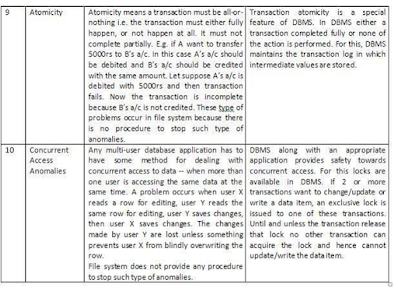It is the management system that allows access to single files (or) tables at a time. It consists of flat file.
The System which allows to access multiple files (or) tables at a time.
|
File
Management System
|
|
|
File: Collection of data (or) Information. example:unstructured data
|
Database: Collection of related files of different groups. example:structured data
|
|
Data (vs)
program problem: In
FMS different program access different file. |
Data (vs)
program solution: In
DBMS only one set of programs access all the data. |
|
Data
inconsistent problem: As same data
resides in many different files The data inconsistency increased. |
Data
inconsistency solution: In DBMS the related data resides in the same
storage location minimizing data in consistency. |
|
Data isolation
problem: As data is scattered in various formats it is difficult to write the programs to retrieve an appropriate data. |
Data isolation solution: As data resides in same storage location it is easy to write the programs to retrieve an appropriate data. |
|
Integrity
problem: To develop the new consistent range in the existing system the code must be in various application. |
Integrity solution: To develop the new consistent range in the existing system the appropriate code must be added in one application program that which access all the data at one time. |
|
Problem in
accessing the data: To access the appropriate data each time the related new information is to be extracted manually. |
Solution in
accessing the data:
To access the appropriate data DBMS consists of one (or) more programs to extract the needed information. |
|
Automicity
problem:
In case of failure in computer system, it is difficult to ensure that the processing data are resorted to the consistent state that exist prior to the failure. |
Automicity solution: In case of failure of a system, the software ensure that the processing data are resorted to the consistent state that exist prior to the failure. |
|
Data redundancy problem: As various copies of same data resides ,the same information is duplicated in several files indicating the redundancy of data which leads to higher storage and access cost. |
Data redundancy
solution: As only one copy of data resides, the same information may not be duplicated avoiding the redundancy of data which leads to minimum storage and access cost. |
|
Concurrent
problem:
To improve the overall performance of data management, multiple users are allowed to update the data concurrently and many results in various changes to various copies by many different applications. |
Concurrent solution:
To improve the overall performance of data management, multiple users are allowed to update the data concurrently where same data files is accessed by multiple users and the last change remains permanent. |
|
Security
problem:
Every user is able to access the data from anywhere as various copies of same data existing in various places and formats. |
Security solution: As a security property, every user of DBMS is able to access only the required data and strictly not allowing to access all the data. |
OR
Components of DBMS :
1. Data Base Engine.
2.Data Dictionary.
3.Query processor.
4.Report writer.
5.Form generator.
6.Application generator.
7.Communication and Integration.
8.Security and other utilities.
DBMS Functions:
1.Data Dictionary management.
2.Data storage management.
3.Data transformation and presentation.
4.Security management.
5.Multiuser access control.
6.Backup and recovery management.
7.Data Integrity management.
8.Data base access language and application
programming interfaces.
9.Data base communication interfaces.
Disadvantages of DBMS:
1.Complexity.
2.Size.
3.Higher impact of failure.
4.Increased costs.
5.Frequent upgrade / replacement cycles.
Applications
of DBMS:
1.Banking.
2.Airlines.
3.Universities.
4.Human resources.
5.Sales.
6.Online retailers.
7.Manufacturing.
8.Science and technology






No comments:
Post a Comment